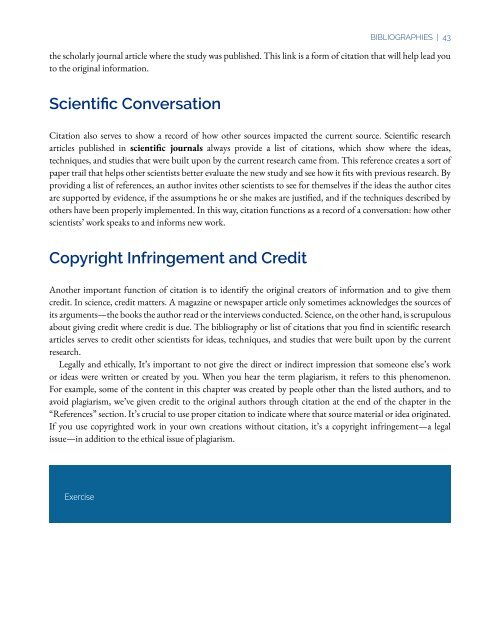An Interactive Introduction to Organismal and Molecular Biology, 2021
An Interactive Introduction to Organismal and Molecular Biology, 2021
An Interactive Introduction to Organismal and Molecular Biology, 2021
Create successful ePaper yourself
Turn your PDF publications into a flip-book with our unique Google optimized e-Paper software.
BIBLIOGRAPHIES | 43<br />
the scholarly journal article where the study was published. This link is a form of citation that will help lead you<br />
<strong>to</strong> the original information.<br />
Scientific Conversation<br />
Citation also serves <strong>to</strong> show a record of how other sources impacted the current source. Scientific research<br />
articles published in scientific journals always provide a list of citations, which show where the ideas,<br />
techniques, <strong>and</strong> studies that were built upon by the current research came from. This reference creates a sort of<br />
paper trail that helps other scientists better evaluate the new study <strong>and</strong> see how it fits with previous research. By<br />
providing a list of references, an author invites other scientists <strong>to</strong> see for themselves if the ideas the author cites<br />
are supported by evidence, if the assumptions he or she makes are justified, <strong>and</strong> if the techniques described by<br />
others have been properly implemented. In this way, citation functions as a record of a conversation: how other<br />
scientists’ work speaks <strong>to</strong> <strong>and</strong> informs new work.<br />
Copyright Infringement <strong>and</strong> Credit<br />
<strong>An</strong>other important function of citation is <strong>to</strong> identify the original crea<strong>to</strong>rs of information <strong>and</strong> <strong>to</strong> give them<br />
credit. In science, credit matters. A magazine or newspaper article only sometimes acknowledges the sources of<br />
its arguments—the books the author read or the interviews conducted. Science, on the other h<strong>and</strong>, is scrupulous<br />
about giving credit where credit is due. The bibliography or list of citations that you find in scientific research<br />
articles serves <strong>to</strong> credit other scientists for ideas, techniques, <strong>and</strong> studies that were built upon by the current<br />
research.<br />
Legally <strong>and</strong> ethically, It’s important <strong>to</strong> not give the direct or indirect impression that someone else’s work<br />
or ideas were written or created by you. When you hear the term plagiarism, it refers <strong>to</strong> this phenomenon.<br />
For example, some of the content in this chapter was created by people other than the listed authors, <strong>and</strong> <strong>to</strong><br />
avoid plagiarism, we’ve given credit <strong>to</strong> the original authors through citation at the end of the chapter in the<br />
“References” section. It’s crucial <strong>to</strong> use proper citation <strong>to</strong> indicate where that source material or idea originated.<br />
If you use copyrighted work in your own creations without citation, it’s a copyright infringement—a legal<br />
issue—in addition <strong>to</strong> the ethical issue of plagiarism.<br />
Exercise


















